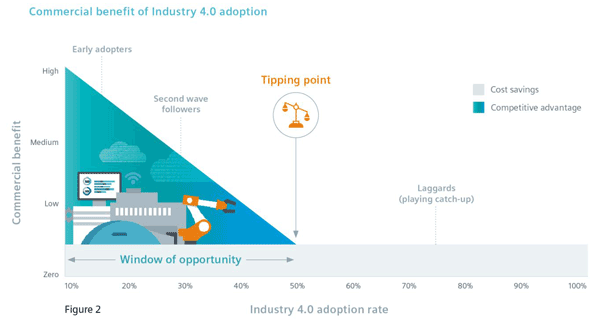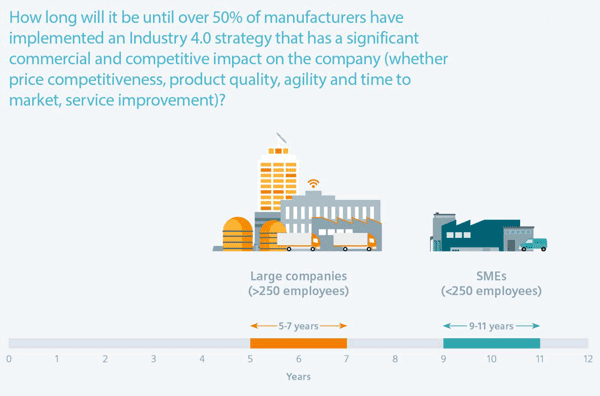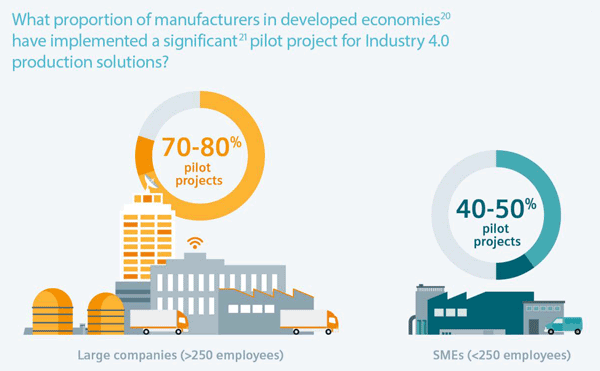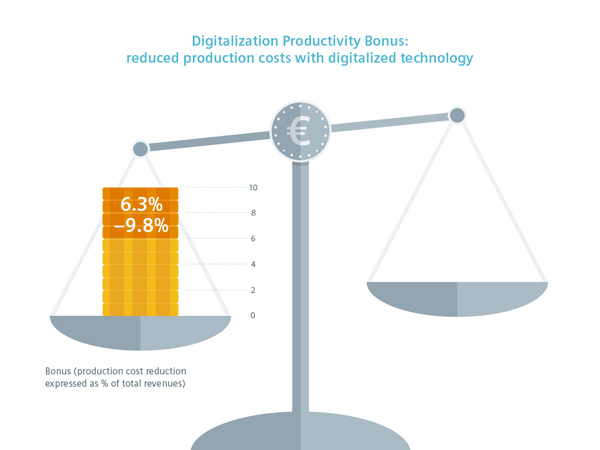
Whilst most manufacturers understand the benefits of investing in digitalised technology, Industry 4.0 requires transformational change at a pace the majority of manufacturers are not yet matching, and time is running out, says Brian Foster, head of industry finance at Siemens Financial Services UK.
The key question relating to digital transformation in manufacturing is no longer ‘whether’ to invest in it but rather ‘when’ to do so.
Whilst most manufacturers understand the benefits of investing in digitalised technology, Industry 4.0 requires transformational change at a pace the majority of manufacturers are not yet matching.
If manufacturers continue on the current trajectory, they are unlikely to meet the realities of manufacturing both now and in the future and may be disrupted by competitors and new market entrants. Accordingly, manufacturers must embrace digitalisation now in order to draw the benefits of early adoption, or else risk being left behind.
Estimating the ‘tipping point’ of Industry 4.0 - the point at which the pioneering first half of manufacturers will have substantially migrated to Industry 4.0 digital production platforms – is the focus of Siemens Financial Services’ (SFS) latest research.
Manufacturers across the world are in a race against time to gain competitive advantage from Industry 4.0 investment before the ‘tipping point’ of majority adoption.
While the first 50% of players to invest in new technologies or business models will gain a significant competitive advantage over rivals (an estimated 25% gain on return on capital employed by 2035), the second half of the manufacturing community will simply be playing a game of catch-up.
Later adopters will still benefit from the cost savings and economies from digital transformation, but their investment will merely represent a must-do strategy of realignment that ensures they can compete in markets at all.
It is therefore critical to know how long the window of opportunity will last for manufacturers to be part of the first cohort in digital transformation.

SFS’s latest report, called Countdown to the tipping point for Industry 4.0, captures testimony from more than 40 manufacturers, trade associations and academics from across the world, in order to forecast the window of opportunity for manufacturers to reap the expected return on investment from their digital transformation initiatives.
Respondents estimated that larger manufacturers would reach this point within five-seven years, whereas SME manufacturers would take nine-11 years, highlighting the two-tier nature of the digital race.
Even within that window of opportunity, the pressure to transform remains high as the competitive advantage from conversion reduces as more manufacturers adopt Industry 4.0 platforms.

Respondents were also asked about the proportion of manufacturers to have implemented a significant Industry 4.0 pilot.
This is an important insight into the current rate of adoption, since many manufacturers start their Industry 4.0 journey by piloting new technology or solutions before embarking on a full roll-out of digital transformation.
The research found that 70-80% of larger manufacturers have implemented a significant pilot project for Industry 4.0 production solutions, compared to 40-50% of SME manufacturers
Although the advantage of scale and market power have placed larger players ahead of the game in terms of pilot testing, their digital transformation is likely to be more complex and drawn-out, which offers small, nimble players an opportunity to challenge a misconception over the achievability of digital transformation by smaller players.

Manufacturers were also interviewed about their views on the role that specialist finance plays in enabling their digital transformation.
Challenges to implementing digital transformation tend to pivot around the issue of finance, such as understanding the commercial benefits of Industry 4.0, knowing that there will be a reliable return-on-investment, and paying for Industry 4.0 technology at a rate that is less than or matches those expected commercial gains.
These hurdles can be tackled using smart finance techniques - known as 'Finance 4.0' - which cover the full range of requirements, from the acquisition of a single digitalised piece of equipment, to financing a whole new factory or even acquiring a competitor.
As the pace of digital transformation gains momentum, manufacturers are increasingly making use of integrated finance options to facilitate their Industry 4.0 investments and accelerate their journey towards digitalisation.
Finance 4.0 arrangements tend to be offered by specialist providers that have a deep understanding of how the digitalised technology works and how that technology can be leveraged to deliver the benefits of digitalisation.
Financiers with knowledge of manufacturing in general, and digitalisation in particular, will adapt the finance arrangement to align with the likely benefits or ‘outcome’ the manufacturer will gain from the technology.
Savings or gains from access to the technology are used to fund monthly payments, making the technology cost-neutral for the manufacturer.
Consideration is given to the complete technology solution in order to identify the best finance package to effectively digitalise a manufacturing facility’s operation.
Furthermore, equipment and technology finance options allow manufacturers to upgrade during the financing period and offer protection against technological obsolescence, providing manufacturers with an additional flexibility to roll out Industry 4.0 and grow at the same fast pace as the accelerating demand for their products.
Whilst the benefits of moving to a digitalised manufacturing environment are clear, the process of transition has to be carefully managed and commercial risk eliminated by rigorously testing new technology in the real-world production environment.

This can often act as a barrier to digital transformation because the manufacturer is discouraged by the idea of having to pay for both the pilot arrangement and the scaled approach during the transition period.
Financing arrangements can response to the challenges of transition by deferring payment for a new system until it is reliably up and running.
This removes the financial challenge of having to pay for the new system while the old one is still running and helps reduce the risk of ‘pilot purgatory’ for manufacturers.
Ultimately, while there is momentum behind the transition to Industry 4.0, the pace of transformation could accelerate, especially as incumbent players look to compete with rival economies, stay ahead of new entrants, and manage disruptive change.
By enabling manufacturers to invest immediately through flexible finance solutions, they are able to secure a competitive advantage from Industry 4.0 before the tipping point is reached, after which the early-mover advantage will have largely diminished.
* Brian Foster (pictured) is head of industry finance at Siemens Financial Services UK. Siemens Financial Services is part of global technology company Siemens, which provides solutions ranging from technology to infrastructure and automation. It employs around 379,000 people and last year had revenues of €83 billion ($94 billion) and net income of €6.1 billion ($6.9 billion). Siemens was listed in 13th place in the 2019 AF50 UK listing of the country's largest asset finance companies, based on net investment in business equipment leasing, and in 21st place in the 2018 AF50 Europe.






